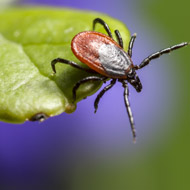Disease-carrying ticks more widespread in US than previously thought

The study found ticks capable of carrying Lyme and other tick-borne diseases in 83 additional US counties.
Residents in North America are being urged to take precautions against Lyme disease after a study found ticks capable of carrying the infection in areas where they had not been previously recorded.
The study, published in the journal PLOS ONE, found ticks capable of carrying Lyme and other tick-borne diseases in 83 additional US counties.
Researchers say that because infected ticks had not been previously recorded in these areas, many of the public health agencies do not have disease risk assessment systems in place and/or do not have requirements to report tick-borne disease.
Linda Giampa, executive director at Bay Area Lyme Foundation, which sponsored the study, said: “Based on these findings, it is critical that residents throughout the country take precautions and know the symptoms of tick-borne infections, even in areas where ticks have not previously been shown to cause disease.”
The finding is the result of a nationwide citizen scientist study conducted by Northern Arizona University (NAU) and Colorado State University.
Between January 2016 and August 2017, more than 16,000 ticks were sent by US citizens to the initiative and tested for four of the most common bacterial infections: Borrelia burgdorferi (Lyme disease); Borrelia miyamotoi (tick-borne relapsing fever); Anaplasma phagocytophilum (human granulocytic anaplasmosis); and Babesia microti (the protozoan pathogen).
Researchers found deer tick and Western black-legged tick populations in 24 US states, including Alabama, Louisiana and Washington. Researchers also found ticks carrying Babesia in 26 counties across 10 states in which the public health department does not require physicians to report cases of babesia.
“The overwhelming study participation from residents throughout the country and the surprising number of counties impacted demonstrates that great interest and need exist throughout the country for this information,” said lead author Nate Nieto, associate professor in NAU’s Department of Biological Sciences.
“This study offers a unique and valuable perspective as it looks at the risk to humans that goes beyond the physician-reported infection rates and involves ticks that were found on or near people.”



 The veterinary mental health charity Vetlife is inviting the veterinary community to join it for a sponsored cold-water dip.
The veterinary mental health charity Vetlife is inviting the veterinary community to join it for a sponsored cold-water dip.